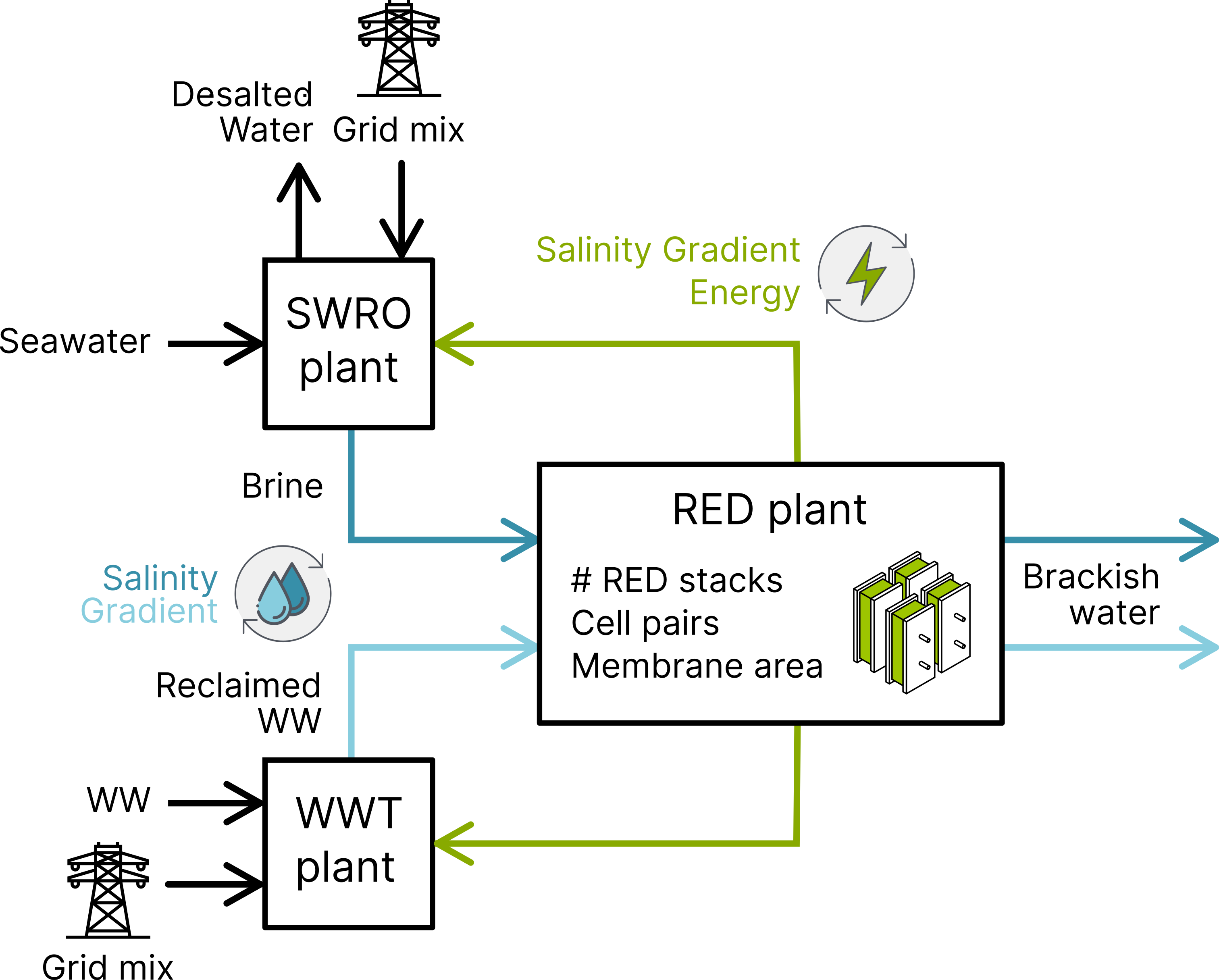Exploiting salinity gradient energy (SGE) via reverse electrodialysis (RED) technology offers a promising solution to produce baseload and clean electricity. The main barriers preventing RED technological readiness are the low power density of large-scale RED systems (0.38–2.7 W m
-2 total membrane area), fouling, and the high cost of commercial membranes (> $100 m
-2) [1]. It is estimated that a net power density of 2 W m
-2 at 40% energy efficiency is the benchmark for RED to be on par with other renewable energy sources [2]. Exploring smaller, specialized markets beyond conventional energy production creates an opportunity to showcase and advance RED market readiness. For instance, disposing seawater desalination brine and reclaimed wastewater effluents generates a prospect to harness energy and reduce the environmental impact of brine disposal [3,4].
Besides, desalination and wastewater reclamation are energy-intensive and, therefore, carbon-intensive processes. RED can convert the salinity difference between these often overlooked streams into electricity, resulting in a more sustainable and circular approach [5].
To reach significant strides in RED, it is key to conduct robust techno-economic assessments encompassing the entire process design and operational decision space, spanning from the RED stack to the whole system. However, estimating the costs and performance of RED using conventional heuristics is not only a technically demanding process but it is unlikely to yield competitive minimum cost designs. This work illustrates the benefits of Generalized Disjunctive Programming (GDP) to define cost-optimal RED process designs that recover energy from desalination concentrates and reclaimed wastewater effluents [6]. Given the concentration, volume, flow rate, and temperature of the high- and low-salinity streams and the RED stack parameters, the optimal solution yields the hydraulic topology and working conditions of the RED stacks that maximize the net present value (NPV) of the RED process.
We code the GDP model using the Python-based, algebraic modeling language Pyomo [7] and Pyomo.GDP, a Pyomo library extension for logic-based modeling and optimization [8]. To solve the GDP problem, we apply the Global Logic-based Outer Approximation (GLOA) algorithm [9,10] implemented in GDPopt. The GLOA algorithm decomposes the solution to the GDP into a sequence of mixed-integer linear programming (MILP) master problems and reduced nonlinear programming (NLP) subproblems.
This work explores how electricity and emissions allowances prices, membranes price, desalination plant capacity, and membranes resistance, may affect the cost-optimal design, economic feasibility, and competitiveness of the RED process. To evaluate the benefits of the GDP model over heuristics, we also compare the conventional series‑parallel configuration with the optimal solution to the GDP problem, which includes recycling and reuse alternatives of the RED units’ exhausted streams. We also assess different sizes and channel dimensions to offer practical guidelines for design and operation in every RED unit and process design development stage. According to our study, incorporating mathematical programming through GDP is more effective and systematic in making decisions to advance full-scale RED progress than relying solely on heuristics and simulation.
By performing a detailed study of the mathematical nature of the GDP problem, we find that nonconvexities in the mixers and the RED unit model may lead to multiple optimal local solutions, therefore requiring computationally demanding global optimization techniques to solve to global optimality. This is particularly true, in large-scale RED systems where the model size grows significantly. A natural progression of this work was to reformulate the nonlinear equations into quadratic or linear approximations to exploit the bilinear nature of the GDP problem that solvers like Gurobi can effectively solve as was shown in our numerical results.
Figure 1 Reverse electrodialysis (RED) plant drawing electricity from the salinity gradient between seawater reverse osmosis (SWRO) desalination’s high-concentration (HC) brine and a reclaimed wastewater (WW) effluent from a WW treatment plant.
References
[1] S. Chae, H. Kim, J. Gi Hong, J. Jang, M. Higa, M. Pishnamazi, J.Y. Choi, R. Chandula Walgama, C. Bae, I.S. Kim, J.S. Park, Clean power generation from salinity gradient using reverse electrodialysis technologies: Recent advances, bottlenecks, and future direction, Chem. Eng. J. 452 (2023) 139482.
[2] J.W. Post, C.H. Goeting, J. Valk, S. Goinga, J. Veerman, H.V.M. Hamelers, P.J.F.M. Hack, Towards implementation of reverse electrodialysis for power generation from salinity gradients, Desalin. Water Treat. 16 (2010) 182–193.
[3] W. Li, W.B. Krantz, E.R. Cornelissen, J.W. Post, A.R.D. Verliefde, C.Y. Tang, A novel hybrid process of reverse electrodialysis and reverse osmosis for low energy seawater desalination and brine management, Appl. Energy. 104 (2013) 592–602.
[4] A. Rani, S.W. Snyder, H. Kim, Z. Lei, S.Y. Pan, Pathways to a net-zero-carbon water sector through energy-extracting wastewater technologies, Npj Clean Water 2022 51. 5 (2022) 1–17.
[5] C. Tristán, M. Fallanza, R. Ibáñez, I. Ortiz, Recovery of salinity gradient energy in desalination plants by reverse electrodialysis, Desalination. 496 (2020) 114699.
[6] C. Tristán, M. Fallanza, R. Ibáñez, I. Ortiz, I.E. Grossmann, A generalized disjunctive programming model for the optimal design of reverse electrodialysis process for salinity gradient-based power generation, Comput. Chem. Eng. 174 (2023) 108196.
[7] W.E. Hart, C.D. Laird, J.-P. Watson, D.L. Woodruff, G.A. Hackebeil, B.L. Nicholson, J.D. Siirola, Pyomo — Optimization Modeling in Python, Second Edi, Springer International Publishing, Cham, 2017.
[8] Q. Chen, E.S. Johnson, D.E. Bernal, R. Valentin, S. Kale, J. Bates, J.D. Siirola, I.E. Grossmann, Pyomo.GDP: an ecosystem for logic based modeling and optimization development, Optim. Eng. 23 (2022) 607–642.
[9] S. Lee, I.E. Grossmann, A global optimization algorithm for nonconvex generalized disjunctive programming and applications to process systems, Comput. Chem. Eng. 25 (2001) 1675–1697.
[10] Q. Chen, E.S. Johnson, J.D. Siirola, I.E. Grossmann, Pyomo.GDP: Disjunctive Models in Python, in: Comput. Aided Chem. Eng., Elsevier B.V., 2018: pp. 889–894.


